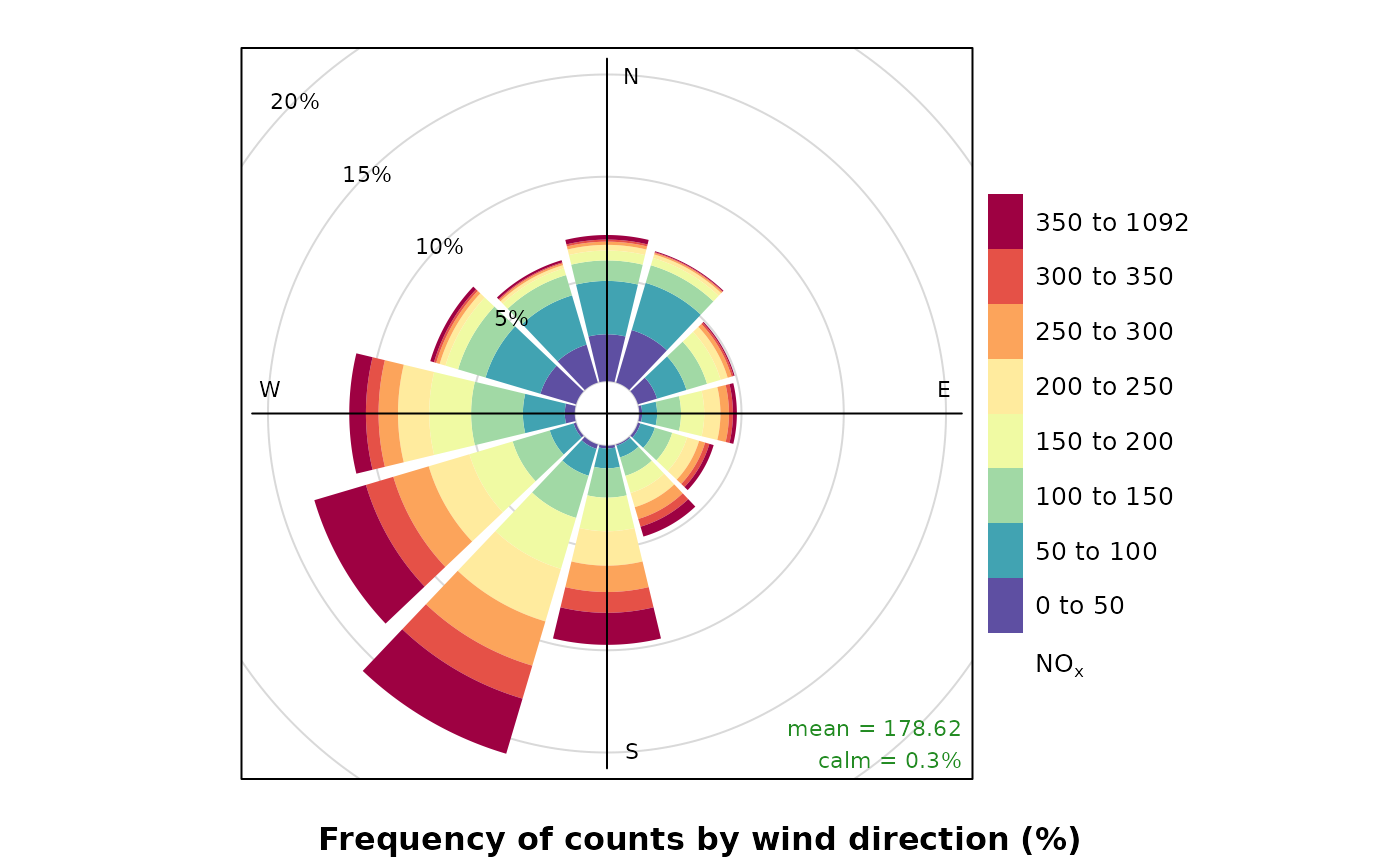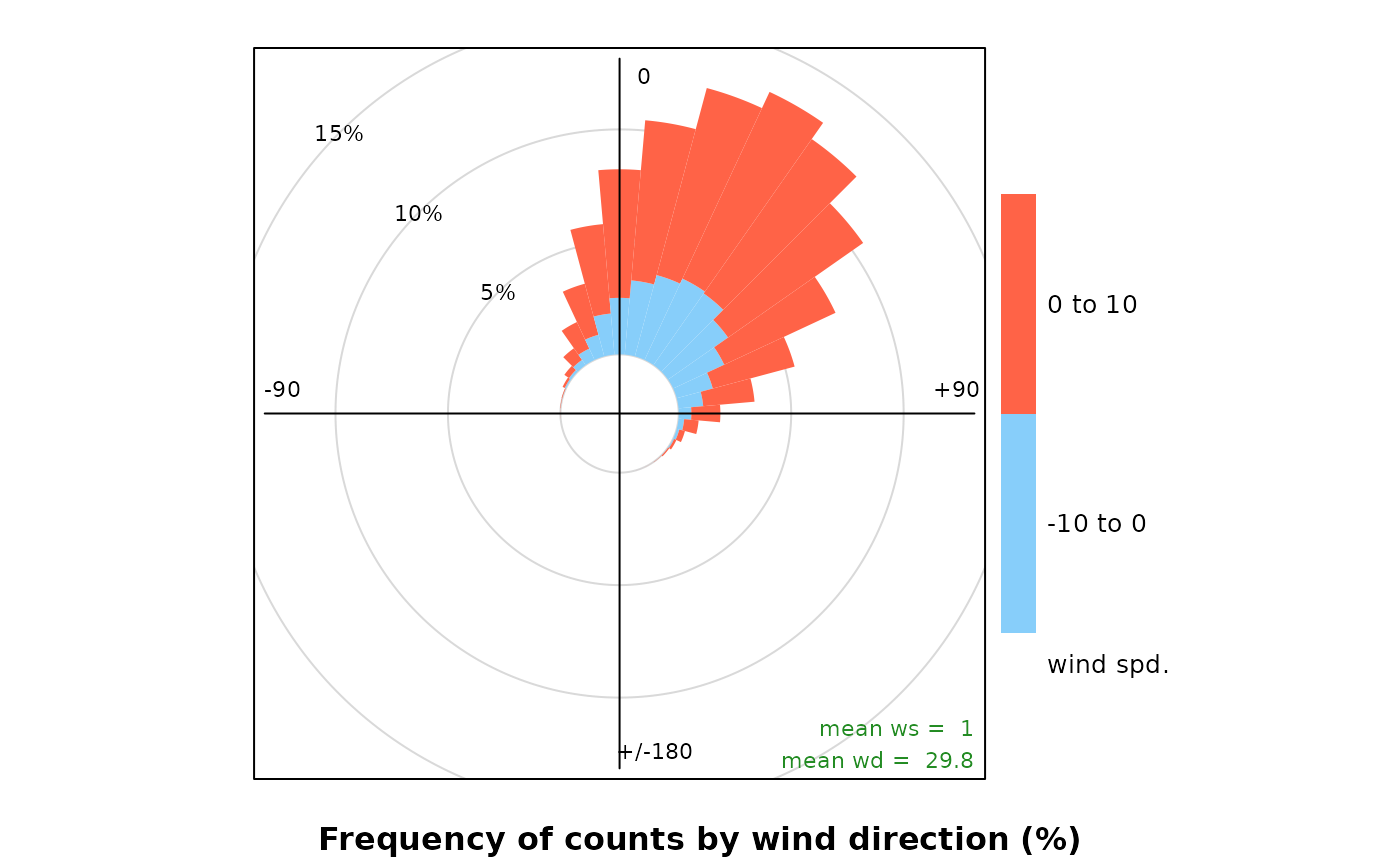The traditional wind rose plot that plots wind speed and wind direction by different intervals. The pollution rose applies the same plot structure but substitutes other measurements, most commonly a pollutant time series, for wind speed.
Usage
pollutionRose(
mydata,
pollutant = "nox",
key.footer = pollutant,
key.position = "right",
key = TRUE,
breaks = 6,
paddle = FALSE,
seg = 0.9,
normalise = FALSE,
alpha = 1,
plot = TRUE,
...
)Arguments
- mydata
A data frame containing fields
wsandwd- pollutant
Mandatory. A pollutant name corresponding to a variable in a data frame should be supplied e.g.
pollutant = "nox".Adds additional text/labels below the scale key. See
key.headerfor further information.- key.position
Location where the scale key is to plotted. Allowed arguments currently include “top”, “right”, “bottom” and “left”.
- key
Fine control of the scale key via
drawOpenKey().- breaks
Most commonly, the number of break points for pollutant concentrations. The default, 6, attempts to breaks the supplied data at approximately 6 sensible break points. However,
breakscan also be used to set specific break points. For example, the argumentbreaks = c(0, 1, 10, 100)breaks the data into segments <1, 1-10, 10-100, >100.- paddle
Either
TRUEorFALSE. IfTRUEplots rose using 'paddle' style spokes. IfFALSEplots rose using 'wedge' style spokes.- seg
When
paddle = TRUE,segdetermines with width of the segments. For example,seg = 0.5will produce segments 0.5 *angle.- normalise
If
TRUEeach wind direction segment is normalised to equal one. This is useful for showing how the concentrations (or other parameters) contribute to each wind sector when the proportion of time the wind is from that direction is low. A line showing the probability that the wind directions is from a particular wind sector is also shown.- alpha
The alpha transparency to use for the plotting surface (a value between 0 and 1 with zero being fully transparent and 1 fully opaque). Setting a value below 1 can be useful when plotting surfaces on a map using the package
openairmaps.- plot
Should a plot be produced?
FALSEcan be useful when analysing data to extract plot components and plotting them in other ways.- ...
Arguments passed on to
windRosewsName of the column representing wind speed.
wdName of the column representing wind direction.
ws2,wd2The user can supply a second set of wind speed and wind direction values with which the first can be compared. See
pollutionRose()for more details.ws.intThe Wind speed interval. Default is 2 m/s but for low met masts with low mean wind speeds a value of 1 or 0.5 m/s may be better.
angleDefault angle of “spokes” is 30. Other potentially useful angles are 45 and 10. Note that the width of the wind speed interval may need adjusting using
width.typetypedetermines how the data are split i.e. conditioned, and then plotted. The default is will produce a single plot using the entire data. Type can be one of the built-in types as detailed incutDatae.g. “season”, “year”, “weekday” and so on. For example,type = "season"will produce four plots — one for each season.It is also possible to choose
typeas another variable in the data frame. If that variable is numeric, then the data will be split into four quantiles (if possible) and labelled accordingly. If type is an existing character or factor variable, then those categories/levels will be used directly. This offers great flexibility for understanding the variation of different variables and how they depend on one another.Type can be up length two e.g.
type = c("season", "weekday")will produce a 2x2 plot split by season and day of the week. Note, when two types are provided the first forms the columns and the second the rows.calm.threshBy default, conditions are considered to be calm when the wind speed is zero. The user can set a different threshold for calms be setting
calm.threshto a higher value. For example,calm.thresh = 0.5will identify wind speeds below 0.5 as calm.bias.corrWhen
angledoes not divide exactly into 360 a bias is introduced in the frequencies when the wind direction is already supplied rounded to the nearest 10 degrees, as is often the case. For example, ifangle = 22.5, N, E, S, W will include 3 wind sectors and all other angles will be two. A bias correction can made to correct for this problem. A simple method according to Applequist (2012) is used to adjust the frequencies.colsColours to be used for plotting. Options include “default”, “increment”, “heat”, “jet”, “hue” and user defined. For user defined the user can supply a list of colour names recognised by R (type
colours()to see the full list). An example would becols = c("yellow", "green", "blue", "black").grid.lineGrid line interval to use. If
NULL, as in default, this is assigned based on the available data range. However, it can also be forced to a specific value, e.g.grid.line = 10.grid.linecan also be a list to control the interval, line type and colour. For examplegrid.line = list(value = 10, lty = 5, col = "purple").widthFor
paddle = TRUE, the adjustment factor for width of wind speed intervals. For example,width = 1.5will make the paddle width 1.5 times wider.auto.textEither
TRUE(default) orFALSE. IfTRUEtitles and axis labels will automatically try and format pollutant names and units properly, e.g., by subscripting the ‘2’ in NO2.offsetThe size of the 'hole' in the middle of the plot, expressed as a percentage of the polar axis scale, default 10.
max.freqControls the scaling used by setting the maximum value for the radial limits. This is useful to ensure several plots use the same radial limits.
key.headerAdds additional text/labels above the scale key. For example, passing
windRose(mydata, key.header = "ws")adds the addition text as a scale header. Note: This argument is passed todrawOpenKey()viaquickText(), applying the auto.text argument, to handle formatting.dig.labThe number of significant figures at which scientific number formatting is used in break point and key labelling. Default 5.
include.lowestLogical. If
FALSE(the default), the first interval will be left exclusive and right inclusive. IfTRUE, the first interval will be left and right inclusive. Passed to theinclude.lowestargument ofcut().statisticThe
statisticto be applied to each data bin in the plot. Options currently include “prop.count”, “prop.mean” and “abs.count”. The default “prop.count” sizes bins according to the proportion of the frequency of measurements. Similarly, “prop.mean” sizes bins according to their relative contribution to the mean. “abs.count” provides the absolute count of measurements in each bin.annotateIf
TRUEthen the percentage calm and mean values are printed in each panel together with a description of the statistic below the plot. If" "then only the statistic is below the plot. Custom annotations may be added by setting value toc("annotation 1", "annotation 2").angle.scaleThe scale is by default shown at a 315 degree angle. Sometimes the placement of the scale may interfere with an interesting feature. The user can therefore set
angle.scaleto another value (between 0 and 360 degrees) to mitigate such problems. For exampleangle.scale = 45will draw the scale heading in a NE direction.borderBorder colour for shaded areas. Default is no border.
Value
an openair object. Summarised proportions can be
extracted directly using the $data operator, e.g.
object$data for output <- windRose(mydata). This returns a
data frame with three set columns: cond, conditioning based on
type; wd, the wind direction; and calm, the
statistic for the proportion of data unattributed to any specific
wind direction because it was collected under calm conditions; and then
several (one for each range binned for the plot) columns giving proportions
of measurements associated with each ws or pollutant range
plotted as a discrete panel.
Details
pollutionRose() is a windRose() wrapper which brings pollutant
forward in the argument list, and attempts to sensibly rescale break points
based on the pollutant data range by by-passing ws.int.
By default, pollutionRose() will plot a pollution rose of nox using
"wedge" style segments and placing the scale key to the right of the plot.
It is possible to compare two wind speed-direction data sets using
pollutionRose(). There are many reasons for doing so e.g. to see how one
site compares with another or for meteorological model evaluation. In this
case, ws and wd are considered to the the reference data sets
with which a second set of wind speed and wind directions are to be compared
(ws2 and wd2). The first set of values is subtracted from the
second and the differences compared. If for example, wd2 was biased
positive compared with wd then pollutionRose will show the bias
in polar coordinates. In its default use, wind direction bias is colour-coded
to show negative bias in one colour and positive bias in another.
See also
Other polar directional analysis functions:
percentileRose(),
polarAnnulus(),
polarCluster(),
polarDiff(),
polarFreq(),
polarPlot(),
windRose()
Examples
# pollutionRose of nox
pollutionRose(mydata, pollutant = "nox")
 ## source apportionment plot - contribution to mean
if (FALSE) { # \dontrun{
pollutionRose(mydata, pollutant = "pm10", type = "year", statistic = "prop.mean")
} # }
## example of comparing 2 met sites
## first we will make some new ws/wd data with a postive bias
mydata$ws2 = mydata$ws + 2 * rnorm(nrow(mydata)) + 1
mydata$wd2 = mydata$wd + 30 * rnorm(nrow(mydata)) + 30
## need to correct negative wd
id <- which(mydata$wd2 < 0)
mydata$wd2[id] <- mydata$wd2[id] + 360
## results show postive bias in wd and ws
pollutionRose(mydata, ws = "ws", wd = "wd", ws2 = "ws2", wd2 = "wd2")
## source apportionment plot - contribution to mean
if (FALSE) { # \dontrun{
pollutionRose(mydata, pollutant = "pm10", type = "year", statistic = "prop.mean")
} # }
## example of comparing 2 met sites
## first we will make some new ws/wd data with a postive bias
mydata$ws2 = mydata$ws + 2 * rnorm(nrow(mydata)) + 1
mydata$wd2 = mydata$wd + 30 * rnorm(nrow(mydata)) + 30
## need to correct negative wd
id <- which(mydata$wd2 < 0)
mydata$wd2[id] <- mydata$wd2[id] + 360
## results show postive bias in wd and ws
pollutionRose(mydata, ws = "ws", wd = "wd", ws2 = "ws2", wd2 = "wd2")

